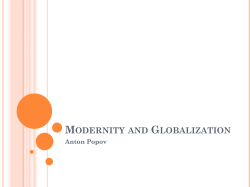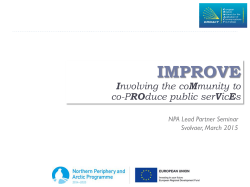
Print - Melbourne Girls Grammar
IMAGINING THE COSMOPOLITAN CLASSROOM: EDUCATION IN TRANSNATIONAL SPACES Joanna Baker Melbourne Girls Grammar School, South Yarra, Australia Abstract In this paper, I will explore the possibilities and challenges presented by the increasingly globalised, transnational nature of social experience. With the spread of access to communication technologies, and the ever-increasing pace of innovation and change, the spaces in which we live and work have been flattened, no longer constrained by geographical, national, or indeed temporal boundaries. Despite this profound shift in the way we perceive and interact with the world, contemporary experiences of education remain largely confined to the four walls of the classroom, where knowledge is abstracted, packaged and ‘delivered’ to students. This traditional model of education - indeed, knowledge itself - has been disrupted by the ‘democratisation’ of access to information, ideas and identities in a networked world. The space in which we live, work, interact and learn is now a transnational one, where knowledge, identities, and cultures are continuously recreated and re-imagined, unmade and remade to suit myriad emerging cultural, technological, geo-political and social contexts. To successfully negotiate and communicate in globalised spaces, individuals must have both an understanding of how these networks function, as well as the skills to operate within these ever-diversifying contexts. As educators, we are impelled to bring the world into the classroom; with the emergence of online, networked learning opportunities, this need not be a one-way process. Introduction Perhaps the most profound - yet least understood - effect of the rapid technological change of recent decades has been the compression of time and space across the globe. As universal access to the the internet becomes a reality, communities and individuals are connected not only to each other, but to vast, ever-increasing volumes of digitised information and ‘content’. Beyond the evident economic and social possibilities of this interconnectivity, Rizvi and Lingard (2010) suggest that this “compression” has enhanced our awareness of “the globe of the world as one place”(p. 66); that interconnectedness has been made visible and livable. This shift has led to the emergence of ‘transnationalism’ as a way of describing how society is now “simultaneously local, national regional and global in terms of experience, politics, effects and imagination.” (Rizvi & Lingard, 2010, p. 62). Transnationalism posits that today, society is no longer a 'place' or static state, but rather a set of dynamic processes through which knowledge, identities and cultures are constructed across borders (Vertovec, 2001), with language and dialogue as the dominant vehicle for such processes (Luke, 2004). Such upheaval in the way we live, learn and experience the world - a revolutionary shift in our conceptualisation of society itself - demands a re-interrogation of both the purpose and the nature of education. Educators, researchers, policymakers, students and parents have all begun to question the relevance of traditional models of education; indeed, to question the core assumptions about knowledge and learning upon which education systems have been constructed for centuries. As we have begun to comprehend the scale and complexity of the processes of globalisation and the “democratisation of knowledge”, we have seen both optimistic (Peters & Fitzsimons, 2012) and cautious (Luke, Luke & Graham, 2007; Papastephanou, 2005) examinations of the potential political, social, economic and personal effects of allpervasive interconnectivity. Such varied accounts nonetheless raise similar questions: ● ● ● What kind of future are we preparing our students for? What do we value as a ‘worthwhile’ outcomes and experiences in education? What new understandings, skills and critical capabilities do students need to navigate hyperconnected, transnational spaces? Here I will explore the both the practical and ethical implications of these questions, drawing on the emergent notion of cosmopolitan learning to examine how we might re-situate the educational experience within dynamic, transnational spaces. How Does Transnationalism Destabilise Traditional Notions of Education? The profound social and economic disruptions caused by globalisation have not been ignored by education policy-makers. In Australia, recent reforms have emphasised the challenges and opportunities presented by “global integration” of societies and economies. The Australian Curriculum identifies key local, regional and global issues that students will need to understand in order to “prosper in a globalised world” (ACARA 2013a). These skills and understandings are, according to the curriculum rationale, aimed at developing “individuals...who behave with ethical integrity, relate to and communicate across cultures, work for the common good and act with responsibility at local, regional and global levels” (ACARA). What is notable in both the curriculum itself, and the strategic statements upon which it is based, are the distinctions made between these three ‘levels’ (local, regional and global); they are conceived as separate ‘places’, to be addressed discretely in the classroom. Transnationalism, by contrast, posits that in contemporary society, these boundaries have dissolved; that the space in which we live, work, interact and learn is increasingly a transnational one, where knowledge, identities, and cultures are continuously recreated and re-imagined across borders (Rizvi, 2011). This demands, then, not only an understanding of the social, economic and political forces at play in any particular ‘place’, but an appreciation of how such forces move between places; that is, the complex interrelationships between the local, regional and global. While the opportunities for empowerment, mobility and new ‘imaginings’ presented by such spaces are not to be underestimated, it is important to acknowledge that transnationalism (as conceived by Vertovec and Rizvi, among others) is not a utopian, egalitarian vision of society. Rather, as with any social site, transnational spaces are necessarily "overlapped with unequal power relations, which reflect both contemporary geopolitics and past political struggles” (Rizvi & Lingard, 2010, p. 62). It is in the movements and interactions between these spaces that power is lost, gained or redefined (Naim, 2013). As Rizvi and Lingard, citing Castells (2000), succinctly put it: “today power is located in flows, while most people still live in the space of places” (p. 66). Empowerment, then, comes not only through understanding the dynamic nature of such ‘flows’ (of capital, information, technology, images, sound and symbols), but also having the skills and critical capabilities to successfully navigate these ever-shifting streams. As Rizvi (2009) argues, such profound shifts require a new approach to education, one which reflects the dynamism and simultaneity of the ‘lived experience’ of transnationalism. Re-situating Education in Transnational Spaces: The Case for Cosmopolitanism While the notion of cosmopolitan learning has clear links to the emergence of transnationalism (as described above) it may also be seen as a response to the increased pervasiveness of globalisation and globalism in education (Papastephanou, 2005). Here, I will look at how Rizvi’s (2009) conceptualisation of cosmopolitan learning calls for a reimagining not only of curriculum (what students learn) and pedagogy (how they learn), but also of the kinds of values that are promoted through the educational experience; that is, an education which “involves a critical hermeneutical politics, a particular way of learning about cultural encounters and about sources of conflict and to imagine alternative futures” (p.263). Cosmopolitanism, in this context, refers to the ‘complex connectivity’ of society (as described by transnationalism), in which our inter-connectedness is conceived as both a socio-cultural and psycho-social condition (Tomlinson, cited in Rizvi 2009). This ‘relational understanding’ of connectivity challenges traditional educational assumptions about knowledge as a static ‘good’, to be transferred from one vessel to another through education. Cosmopolitanism operates from a socialconstructivist perspective, emphasising that “knowledge is distributive, that is, not located in any given place [...] but rather consists of the network of connections formed from experience and interactions with a knowing community” (Downes, 2006). This has profound implications for curriculum formations, which traditionally articulate the particular ‘knowledge’ that students will ‘acquire’. This approach, Rizvi argues, does not make visible the ways in which knowledge is shaped by (and shapes) individual perspectives, and how it is subject to transformation through interaction. A cosmopolitan curriculum, then, would emphasise the notion that “each experience of connectivity has a specific history from which it has emerged [...] and that it is not only experienced differently, but is also interpreted differently in different contexts” (Rizvi, 2009, p.263). In presenting this ‘relational’ understanding of knowledge, Beck (cited in Rizvi, 2009) notes that students must be given the opportunity to “become self-conscious and knowledgeable about their own perspective”; that is, that they are able to critically examine the dynamic interplay of the personal, social, global ‘imagination’ in the formation of their own subjectivity (Appadurai, 1996). While such ideals are not new in education, Rizvi suggests that this understanding should be promoted through pedagogy; that a cosmopolitan approach to pedagogy would involve students actively exploring and participating in the “criss-crossing of transnational circuits of communication,” experiencing the “crosscutting of local, translocal and transnational social practices” (p. 268). In other words, students develop an understanding of the dynamic processes of global connectivity through critical engagement with - and participation in - transnational social formations. Indeed, it is through such interactive, dialogic learning experiences that students encounter contested ways of thinking, being, and knowing, prompting reflection on the unstable, ever-shifting constructions of individual and group identities. Rizvi argues that the promotion of intersubjective understanding is perhaps the most important dimension of cosmipolitan learning, echoing Appiah’s (1996) notion of cosmopolitanism as an ‘ethical attitude’ (cited in Rizvi, 2009). Papastephanou (2005) likewise sees cosmopolitanism as an ethical approach to education, a means of encouraging “a different way of relating to otherness” beyond in resistance to the dominant discourses of competition and capitalism promoted by ‘topdown’ globalisation (p. 547). Such an approach acknowledges that education is never ‘value-free’, and suggests that in an increasingly interdependent, interconnected world, the values of democracy, equality, and respect for difference are more important than ever in pursuing the ‘cosmopolitan ideal’ - “a world in which we can speak as equals” (Luke et al, 2007, p. 12). Cosmopolitan Learning in The Digital Age: Challenges and Possibilties While Rizvi’s notion of cosmopolitan learning is grounded by a set of values, its vision for a ‘cosmpolitan’ approach to teaching and learning shares many common underpinnings with other contemporary approaches to curriculum and pedagogy. Through identifying these epistemic and theoretical commonalities, we begin to see how cosmopolitan learning might serve as a means of unifying and synchronising ideas about what and how students learn, and how schooling itself might be transformed to harness (and make visible) the interconnectedness of transnational spaces. Perhaps the most challenging aspect of cosmopolitan learning is its epistemological underpinning: that knowledge is socially constructed, thus unstable and contestable. Such a position renders irrelevant traditional ideas about education as simply the transfer of knowledge, or (in contemporary terms) the delivery of content. This social-constructivist perspective on knowledge (evident in Vertovec’s conceptualisation of transnationalism [2001]) underpins contemporary educational approaches such as connectivism, social learning, and situated cognition, each of which takes for granted that knowledge is constructed and negotiated (Downes, 2006). While the notion of knowledge as ‘relative’ has long been present in debates about the purpose and processes of education, the pervasiveness of digital ‘knowledge networks’ makes visible these negotiated, contested processes of knowledge construction, reinforcing the notion of knowledge as distributive, while also opening up spaces for students to participate in and contribute to such processes. The potential benefits of experiencing knowledge as distributive are emphasised in contemporary theories of cognition, which suggest that knowledge within the brain is takes the form of a distributive ‘network, and that learning “learning is a process of connecting specialised nodes or information sources” (Siemens, 2005). The theory of ‘situated cognition’ (Lave & Wenger, 1991; Brown, Collins & Duguid, 1988) takes this idea further, suggesting that rich, enduring learning happens when students make connections between ideas and their contexts. That is, rather than presenting concepts as isolated and abstracted, students experience new ideas as embedded in - and emerging from - their ‘real-world’ contexts, with explicit exploration of the relationship between the two. This emphasis on the inseparability of knowing and doing - that knowledge is “fundamentally a co-production between the mind and the world” (Brown et al, 1988, p.33) - aligns clearly with cosmopolitanism’s notion of interconnectedness as a socio-cultural and psychological condition (Tomlinson, cited in Rizvi, 2009). Proponents of both situated learning and cosmopolitan learning thus argue for ‘authentic’ educational experiences, where the dynamic processes of global connectivity are made tangible and examinable. How, then, can educators facilitate such ‘authentic’, embedded learning experiences? Connectivist and networked approaches to learning posit that globe-spanning digital networks provide new opportunities for learning which is dynamic and interactive, developing students’ communicative and collaborative skills while enhancing their understanding that “what we ‘know’ is embedded in our network of connections to each other, to resources, to the world” (Downes, 2006). Again, we see that this is not necessarily a ‘new’ concept; indeed, Bandura’s theory of ‘social learning’ (1971) is founded on the notion of a two-way relationship between environment (community/network) and individual: that “behaviour partly creates the environment and the resultant environment, in turn, influences the behaviour” (p. 40). Bandura argued that this demands a responsive pedagogy which embeds learning in social and interactive contexts. Connectivist and networked approaches to learning reinvent this notion for the digital age, developing a vision of technology-based learning which emphasises interaction, conversation, and participation embedded in meaningful contexts. While noting that the pedagogy of these approaches is still emerging, Hodgson, McConnell and DirckinckHolmfeld (2012) identify inclusion, critical reflexivity and relational dialogue as core ‘values’, and argue that technology can play a key role in connecting and mediating learning. Similarly, Downes (2006) imagines networked learning as a “conversation” between a learner and other members of a learning community, and suggesting that it is through such dialogic interactions “that new knowledge is discovered, where the creation of connections is a core function”. Like cosmopolitanism, this approach emphasises that it is though the ‘lived experience’ of interconnectedness that we develop not only the skills to negotiate ‘de-territorialised’ communities (Tomlinson, cited in Rizvi 2011), but also a critical understanding of, as Rizvi (2009) puts it, “the contested politics of place making, the social constructions of power differentials and the dynamic processes relating to the formation of individual, group, national and transnational identities, and their corresponding fields of difference” (p. 265). So, we see that while there are several educational ideas which share a social-constructivist conceptualisation of knowledge (and thus learning), cosmopolitanism serves to unify both the cognitive and ethical dimensions of this perspective. As an approach to learning, cosmopolitanism acknowledges explicitly the distributive nature of knowledge, and calls for a pedagogy which makes use of - and critically examines - the dialogic, interdependent relationship between individuals and the trans-border social formations in which they move and interact. Conclusion As educators, we have an obligation to prepare our students for the world they will have to negotiate when they leave our four walls - a global society that is increasingly interconnected and - more importantly - interdependent. Those who flourish will be those who can comprehend, negotiate, and harness the dynamic, ever-shifting forces of transnational identities, cultures, and economies. This requires new ways of thinking about the what, why and how of contemporary education. As Luke et al (2007) suggest, if we are to make learning purposeful, relevant and authentic, we must “must radically expand the purview, scope and gaze of the school curriculum” (p. 12). This means a dynamic, interconnected approach to learning which reflects the dynamic, interconnected world in which we live. Students must also be empowered to use these understandings to make sense of the transnational spaces in which we live and work; to participate actively and critically in diverse communities and networks. This requires skills not only in collaborating, communicating and creating, but also critically analysing and deconstructing existing ways of doing, thinking and being. As Koh and Kenway (2012) argue, it is through development of both communicative and critical skills that students are able to “imagine a ‘new’ world or ‘new society’ and, by inference, to visualise themselves as effecting and leading this social transformation.” (p.347-348). So, we see how a cosmopolitan approach to learning has the potential to be truly transformative, disrupting traditional ideas about not only the experience of education, but the purpose of education. As an educational ideal, cosmopolitanism seeks to promote personal understandings of the interconnectedness and interdependence between individuals; to reconceptualise identities and communities beyond the nation (Rizvi & Lingard, 2011). It aims to cultivate critical, reflective subjectivities in learners, and to mediate the effects of ‘top-down’ globalisation by strengthening and enhancing global interaction through dynamic, democratic networks (Papastephanou, 2005). In a ‘cosmopolitan’ education, learning is resituated within transnational spaces, exposing the pervasiveness of the global connectivity and providing opportunities for communication and identity formation across and within cultures. In this way, cosmopolitan learning provides an ethical, humanistic framework for understanding interaction and conflict, empowering students to imagine alternative futures, for themselves and for the global community. References Appadurai, A. (1996). Modernity at large: Cultural dimensions of globalization (Vol. 1). Minnesota: University of Minnesota Press. Bandura, A. (1971). Social learning theory. New York: General Learning Corporation. Retrieved from http://www.jku.at/org/content/e54521/e54528/e54529/e178059/Bandura_SocialLearningTheory_ger.pdf. Brown, J. S., Collins, A., & Duguid, P. (1989). Situated cognition and the culture of learning. Educational researcher, 18(1), 32-42. Retrieved from http://www.dtic.mil/dtic/tr/fulltext/u2/a204690.pdf. Dirckinck-Holmfeld, L., Hodgson, V. E., & McConnell, D. (2012). The theory, pedagogy and practice of networked learning. In L.D. Dirckinck-Holmfeld, V. Hodgson, and D. McConnell (Eds.), Exploring the theory, pedagogy and practice of networked learning, 291-306. New York, NY : Springer. Downes, S. (2006). Learning networks and connective knowledge. Retrieved from http://it.coe.uga.edu/itforum/paper92/paper92.html. Lave, J., & Wenger, E. (1991). Situated learning: Legitimate peripheral participation. Cambridge: Cambridge University Press. Luke, A. (2004). Teaching after the market: From commodity to cosmopolitan. Teachers College Record, 106(7), 14221443. Luke, A., Luke, C., & Graham, P. W. (2007). Globalization, corporatism, and critical language education. International Multilingual Research Journal 1(1), 1-13. Retrieved from http://eprints.qut.edu.au/15126/1/15126.pdf. Naím, M. (2013). The end of power: From boardrooms to battlefields and churches to states, why being in charge isn't what it used to be. New York: Basic Books. Papastephanou, M. (2005). Globalisation, globalism and cosmopolitanism as an educational ideal. Educational Philosophy & Theory, 37(4), 533-551. doi:10.1111/j.1469-5812.2005.00139.x. Rizvi, F. (2009). Towards cosmopolitan learning. Discourse: Studies in the Cultural Politics of Education, 30(3), 253-268. Retrieved from http://repository.unimelb.edu.au.ezp.lib.unimelb.edu.au/10187/14831. Rizvi, F., & Lingard, B. (2010). Globalizing Education Policy, (Chapter 3). London, England: Routledge. Retrieved from http://app.lms.unimelb.edu.au/bbcswebdav/pid-3864002-dt-content-rid-11704606_2/ courses/EDUC90620_2013_SM1/Globalising%20education%20policy%20analysis_Rizvi_Lingard_2010_Scanned.pdf. Siemens, G. (2005). Connectivism: A learning theory for the digital age. International Journal of Instructional Technology and Distance Learning, 2(1). Retrieved from http://www.itdl.org/Journal/Jan_05/article01.htm. Vertovec, S. (2001). Transnationalism and identity. Journal Of Ethnic & Migration Studies, 27(4), 573-582. doi:10.1080/13691830120090386.
© Copyright 2025










